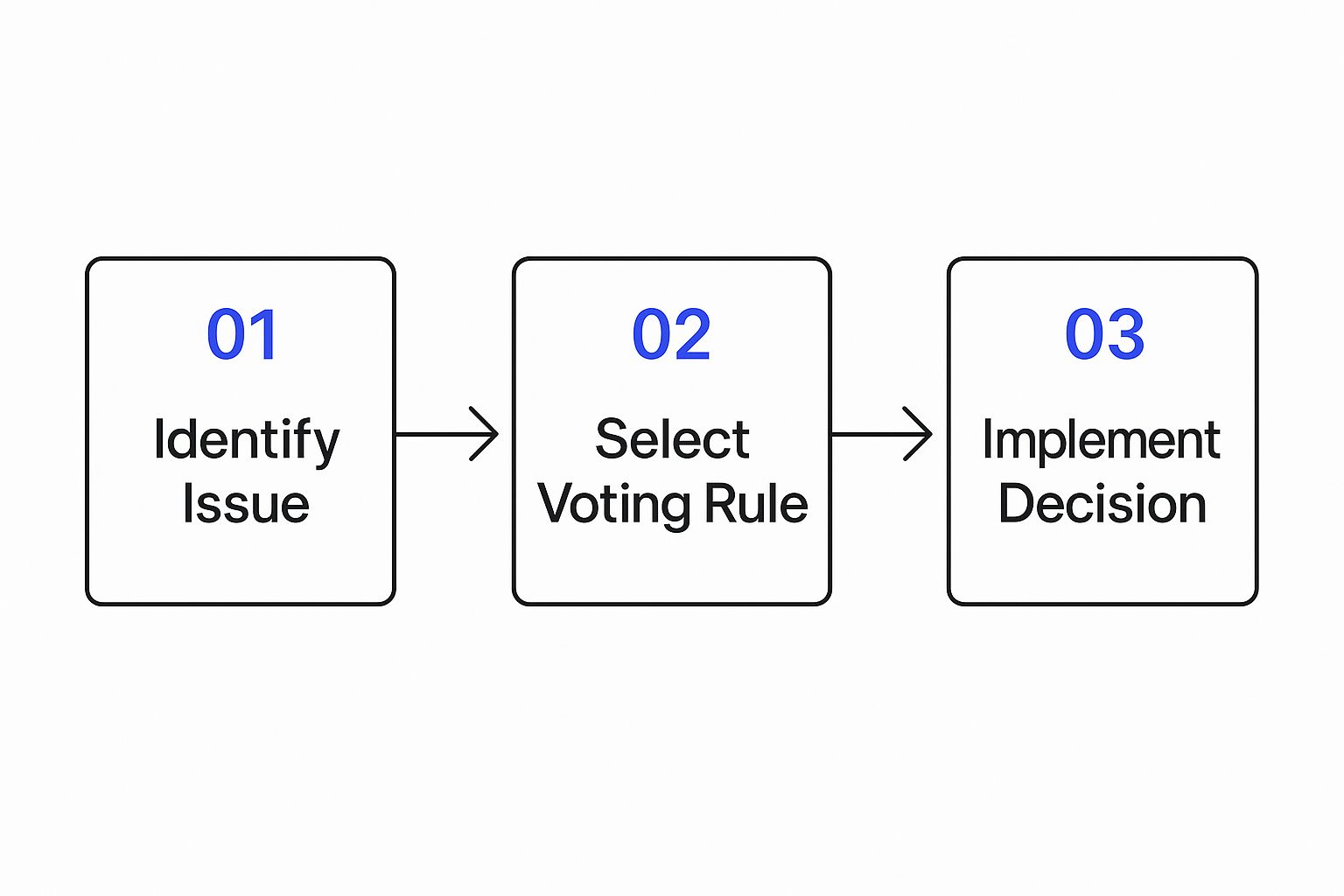
Learning how to write a partnership agreement is one of the most foundational steps you’ll take as an entrepreneur. It’s all about creating a legally solid contract that clearly maps out the rights, responsibilities, and day-to-day operating rules for every partner involved. Think of it as the ultimate guide for running your business and navigating any bumps in the road.
Why a Handshake Agreement Is a Business Risk
Before we get into the nuts and bolts of drafting an agreement, let’s talk about why it's so critical. It’s incredibly common for entrepreneurs, especially friends or family, to launch a business on a handshake and a shared dream. While that trust and collaboration feel great at the start, it leaves your business wide open to misunderstandings, personal fallouts, and absolute financial chaos down the line.
A formal partnership agreement is much more than a stuffy legal document; it’s the roadmap for your entire business. It turns vague assumptions into concrete, agreed-upon rules, making sure everyone is on the exact same page from day one. This isn't just some tedious legal chore—it's one of the first and most important moves you can make to build a resilient, successful business.
Setting Clear Expectations from the Start
Imagine two partners start a marketing agency. One is a rainmaker, using their massive network to bring in all the clients. The other is the creative genius who does all the actual work. Without an agreement, how do you decide if profits get split 50/50? What happens when the creative partner starts feeling like they're carrying all the weight?
A well-crafted agreement stops these problems before they start by defining the essentials upfront:
- Roles and Responsibilities: Who’s handling sales, operations, finance, and marketing? Be specific.
- Financial Contributions: How much cash is each partner putting in? What’s the value of non-cash contributions, like expensive equipment or valuable intellectual property?
- Decision-Making: How will you make the big calls? Does every major decision need a unanimous vote, or will a simple majority do?
Putting these details in writing eliminates ambiguity. It forces you and your partners to have the tough, necessary conversations before they turn into full-blown crises, creating a framework that can handle the real-world pressures of running a business.
A Shield Against Costly Conflicts
Let's be blunt: partner disputes are a primary reason businesses go under. According to a study by the U.S. Small Business Administration, around 50% of small businesses fail within their first five years, and conflict between partners is a major culprit. The same research, detailed by SkyQuest, found that partnerships with written agreements have a conflict rate below 10%. That’s a massive drop from the 30% conflict rate for businesses relying on verbal understandings.
A partnership agreement is like a pre-nup for your business. You don't create it because you expect to fail; you create it to have a clear, fair plan that protects everyone’s interests if things don’t go as planned.
By deciding ahead of time how you’ll handle disagreements, buyouts, or even closing the business, you create a logical path forward. This foresight can save you tens of thousands in legal fees and, more importantly, might just save your business and your personal relationships when things get tough. Without it, you’re basically leaving your future up to chance—and the court system.
Before we dive deeper, here is a quick overview of the core elements your agreement must contain.
Core Components of a Partnership Agreement at a Glance
| Component | Why It's Crucial |
|---|---|
| Partner Contributions | Clarifies initial cash, asset, or IP investments to establish ownership stakes. |
| Roles & Responsibilities | Defines who does what, preventing operational overlap and unmet duties. |
| Profit & Loss Distribution | Sets clear rules for how money is shared, avoiding financial disputes. |
| Decision-Making & Voting | Establishes how major business decisions are made (majority vs. unanimous). |
| Dispute Resolution | Provides a pre-agreed process for handling disagreements, saving time and money. |
| Partner Exit/Buyout | Outlines what happens if a partner leaves, dies, or wants to sell their share. |
| Dissolution Clause | Creates a clear roadmap for winding down the business if necessary. |
This table covers the absolute must-haves. A strong agreement will go into even more detail, but getting these fundamentals right is the first step toward building a partnership that can last.
Defining Partner Contributions and Ownership Stakes

Alright, this is where you roll up your sleeves. Before you start dreaming about profits or who gets the final say, you have to nail down exactly what each partner is bringing to the business and how that translates to their ownership stake.
Getting this right is the bedrock of your partnership. It’s the part of the agreement that will keep things steady when the pressure is on. This isn't just about who writes the biggest check; it's about recognizing every contribution that builds the business from the ground up.
Valuing More Than Just Cash
It’s rare for partners to start on a 50/50 cash basis. More often, one person brings the capital while another contributes something just as valuable, like a patent, a client list that took a decade to build, or the very equipment you need to operate.
To build a fair ownership structure, you have to put a real-world dollar value on these non-cash assets. This is where many partnerships stumble, but it's crucial for preventing future arguments.
- Intellectual Property (IP): Think patents, trademarks, or proprietary code. You can estimate its value based on what it would cost to license it or build it from scratch.
- Physical Assets: That server rack, delivery van, or office furniture has value. It should be recorded at its fair market value—what it’s worth today, not what was paid for it years ago.
- Client Lists and Networks: A solid book of business is worth its weight in gold. Estimate its value based on the revenue you project those clients will bring in over the first year or two.
- "Sweat Equity": This is the value of the work someone puts in before the business is even making money. It can be tricky to quantify, but you can assign a fair hourly rate for the time spent, based on industry standards.
Getting a third-party appraisal for big-ticket items like IP or specialized machinery is one of the smartest moves you can make. It takes the guesswork and emotion out of the equation and gives everyone a solid, defensible number to work with.
This level of detail is a key part of good small business contract management. When every contribution is formally documented, your agreement becomes stronger and less likely to cause friction later.
Calculating Ownership Percentages
Once every contribution has a dollar value, figuring out the ownership stakes is just simple math. But don’t let the simplicity fool you—this calculation is critical.
Let's walk through an example. Say two partners, Alex and Ben, are launching a tech startup.
Alex’s Contributions:
- Cash Investment: $50,000
- Proprietary Software (appraised value): $75,000
- Total Contribution: $125,000
Ben’s Contributions:
- Cash Investment: $25,000
- High-End Server Equipment (fair market value): $25,000
- Established Client List (projected first-year value): $50,000
- Total Contribution: $100,000
Together, their contributions create a total initial business capitalization of $225,000.
Now, we can calculate ownership percentages:
- Alex's Ownership: ($125,000 / $225,000) = 55.6%
- Ben's Ownership: ($100,000 / $225,000) = 44.4%
These percentages must be clearly written into the partnership agreement. They're not just numbers; they directly influence how you'll split profits, handle losses, and distribute voting power—all things we'll get into next.
By taking this transparent approach, you turn subjective feelings about fairness into objective, documented facts. It builds a foundation of trust that will carry your partnership forward.
Structuring Roles and Decision-Making Authority
 Once you’ve settled on contributions and ownership, it’s time to get into the operational nitty-gritty. This is where you map out who’s actually in charge of what. Trust me, ambiguity here is a one-way ticket to operational chaos, blown deadlines, and simmering resentment between partners.
Once you’ve settled on contributions and ownership, it’s time to get into the operational nitty-gritty. This is where you map out who’s actually in charge of what. Trust me, ambiguity here is a one-way ticket to operational chaos, blown deadlines, and simmering resentment between partners.
Fancy-sounding titles like "Co-Founder" or "Managing Partner" look great on a business card but mean next to nothing in a legal document. Your partnership agreement needs to go way beyond titles and assign clear, specific duties. This isn't just about avoiding overlap; it's about creating accountability and making sure every critical business function has a dedicated owner.
Assigning Specific Duties and Responsibilities
Think of your business like a machine. For it to run, every part needs someone responsible for keeping it in top shape. A great starting point is to list out every major function of the business and assign a primary "owner" to each one.
Let’s say you're launching a two-person consulting firm. The roles could break down something like this:
Partner A (The "Closer"):
- Takes the lead on all sales and bringing in new clients.
- Manages marketing campaigns and handles public relations.
- Negotiates all client contracts.
Partner B (The "Deliverer"):
- Oversees project execution and ensures service quality.
- Manages the project team and handles the day-to-day operations.
- Deals with client billing and all financial reporting.
See how specific that is? There’s no room for doubt. When a new lead comes in, everyone knows it lands on Partner A’s desk. If a project hits a snag, Partner B is the one to step in. This level of clarity is vital for a smooth workflow and totally avoids the dreaded, "I thought you were handling that" conversation.
Establishing a Clear Decision-Making Framework
Beyond the day-to-day, you need a rulebook for the big, business-altering decisions. Not every choice is created equal, so your agreement should lay out different voting requirements for different types of decisions. This is one of the most critical clauses for ensuring your partnership has long-term stability.
A recent survey of North American SMEs found that while 70% of written partnership agreements define roles, many don't detail the decision-making process with nearly enough rigor.
A tiered approach is usually the most effective:
Decisions Requiring a Unanimous Vote: These are the "bet the company" moves that would fundamentally alter the business. Every single partner has to be on board.
- Selling the business or merging with another company.
- Taking on significant debt over a set limit (e.g., $50,000).
- Bringing in a new partner or changing ownership stakes.
- Pivoting the core business model.
Decisions Requiring a Majority Vote: These are for major operational choices that won’t sink the company but are still pretty significant.
- Hiring key employees or senior managers.
- Approving the annual budget.
- Signing major contracts with vendors or suppliers.
- Making capital expenditures above a certain threshold (e.g., $10,000).
For the smaller, routine stuff, the partner in charge of that area (as defined by their role) can usually make the call on their own. This setup empowers partners to act, while still keeping crucial checks and balances in place.
Pro Tip: Defining these decision-making thresholds is a negotiation in itself. It forces an upfront conversation about everyone's comfort level with risk and autonomy. Our guide on how to negotiate contracts has some great strategies you can apply to these internal talks.
Creating a Tie-Breaking Mechanism
If you have an even number of partners, a deadlock isn't a possibility—it's an inevitability. A 50/50 stalemate on a critical vote can bring your entire business to a grinding halt. You absolutely must have a tie-breaking mechanism in your agreement to prevent this kind of paralysis.
Here are a few common solutions:
- Designated Tie-Breaker: One partner is given slightly more voting power (like 51%) but only for tie-breaking situations.
- Third-Party Mediation: If a deadlock drags on for a set time (say, 30 days), a neutral third-party mediator is brought in to help you find a resolution.
- Escalation Clause: The dispute gets kicked up to a board of advisors or a trusted external consultant, whose recommendation is binding.
It’s infinitely easier to agree on a method now than to try and figure it out in the middle of a heated argument. By structuring roles and decisions with this much detail, you’re building a resilient framework that helps your partnership run smoothly and resolve conflicts logically.
Managing Your Partnership's Finances
Let’s talk about the part of the partnership that often makes or breaks it: money. If you don't define your financial plan with crystal-clear terms, you're essentially setting a ticking time bomb. This is where we move past the handshake and into the nitty-gritty rules that will govern your business's cash flow, how partners get paid, and its overall financial health.
Getting these financial clauses right in your agreement isn't just a good idea; it's non-negotiable. It forces you to have structured, fair conversations about money before it becomes an emotional issue during a cash crunch.
Structuring Profit and Loss Distribution
The first question every partner asks is, "How do we split the profits?" It sounds simple, but the model you choose says a lot about your partnership's values. You also have to decide how losses will be handled—a tough conversation now, but one that’s critical for survival later.
- Pro-Rata Distribution: This is the most straightforward method. Profits and losses are split based on each partner's ownership percentage. If you own 60% of the business, you get 60% of the profits and cover 60% of the losses. Simple as that.
- Performance-Based Distribution: This model is great when a partner's contributions are directly tied to revenue. For example, a sales-focused partner might get a bonus tied to hitting specific targets before the rest of the profits are divided by ownership stake.
- Tiered Distribution: Here, the profit-sharing percentages shift as the business grows. You might agree to split the first $100,000 in profit 50/50. After that, any additional profit could be split 60/40 to reward the partner who's shouldering more of the operational burden.
Deciding how to share losses is equally important. While they're usually allocated pro-rata just like profits, you can get creative. For instance, you could agree that losses are first covered by reinvesting profits before they hit any partner's personal finances.
Defining Partner Salaries Versus Draws
How partners actually get paid is a common point of confusion. It’s absolutely vital to distinguish between a salary and a draw, as they have completely different implications for your business's financial stability and your personal taxes.
A partner salary, often called a "guaranteed payment," is a fixed amount you receive for your active work, regardless of whether the business is profitable that month. Think of it as a business expense, just like paying an employee. This approach provides predictable income for partners running the day-to-day operations.
A partner draw, on the other hand, is a distribution of profits. It isn’t a business expense. Partners take draws from their share of the business's accumulated profits. Your agreement needs to spell out:
- How often draws can be taken (monthly, quarterly, etc.).
- If draws are capped at a certain percentage of available profits.
- What happens if a partner’s draw account goes into the red.
The most stable partnerships I've seen often use a hybrid model. They pay modest guaranteed salaries to cover basic living expenses, then distribute extra profits through quarterly or annual draws. This protects the business’s cash flow while still rewarding everyone for a great year.
Planning for Capital Calls
What happens when the business needs a cash injection to survive a slow period or fund a new growth opportunity? You can't just hope everyone will be willing—or able—to write a check. This is where a capital call clause saves the day.
This clause formally outlines the procedure for requesting more money from the partners. A solid capital call provision will answer these key questions:
- Who can initiate a capital call? Does it need a majority vote or unanimous agreement?
- How are contributions calculated? Is it based on ownership percentage?
- What's the deadline for payment? Partners need a reasonable window, like 30 or 60 days.
- What happens if someone doesn't contribute? This is the most critical part. Your agreement must have a remedy if a partner can't or won't pay up.
This infographic lays out a simple flow for working through these kinds of critical financial and operational decisions.

A clear, logical progression like this helps prevent decision-making from grinding to a halt, especially when the financial stakes are high.
A common penalty for failing to meet a capital call is equity dilution. The partner who didn't contribute sees their ownership stake shrink, while the partners who did contribute see theirs grow. It’s a tough but fair mechanism that protects the business and rewards the partners who stepped up. By documenting these financial rules, you turn money from a potential source of conflict into just another manageable part of your business.
Planning for Every Exit Scenario

It feels strange to plan the end of a partnership when it's just getting started. But trust me, it’s one of the most critical things you can do. A business journey isn’t always a straight line—there are plenty of off-ramps, and planning for them from day one protects everyone’s time, money, and sanity.
Think of this part of your agreement as the ultimate "what if" plan. It creates a clear, pre-agreed path for when a partner leaves, whether by choice or not. This foresight is what keeps a business transition smooth instead of letting it spiral into chaos and expensive legal battles.
Identifying the Trigger Events
First things first, you need to spell out the exact circumstances that would trigger a buyout or even the dissolution of the partnership. These are the life events and business decisions that force a formal change in ownership.
You’ll want to cover the most common scenarios:
- Voluntary Exit: A partner decides to retire, resign, or chase a new dream.
- Death of a Partner: The agreement needs to dictate how the deceased partner's share is handled, protecting both their estate and the ongoing business.
- Disability: A long-term physical or mental disability prevents a partner from carrying out their duties.
- Involuntary Removal: A partner is forced out for specific reasons defined in the agreement, like fraud, a felony conviction, or a serious breach of the contract.
By listing these events clearly, you get rid of all the guesswork. When one of these situations pops up, the agreement’s instructions kick in automatically. No panic, no scrambling—just a structured process.
Establishing a Fair Buyout Process
Once a trigger event happens, the next question is a big one: How will the departing partner's share be valued and paid out? This is precisely where partnerships without a solid agreement tend to fall apart. A well-written buyout clause, often called a "buy-sell agreement," is your best defense against that.
The process really boils down to two key pieces: valuation and payment terms.
1. Business Valuation Methods How do you agree on a fair price for a partner's stake? Your agreement must specify the method you'll use. This prevents arguments over the company's worth during what is already a stressful time.
Here are a few common approaches:
- Agreed-Upon Value: Partners can set a fixed value for the business and agree to review and update it annually. It’s simple, but you have to stay on top of it, or it quickly becomes outdated.
- Formula-Based Value: You can use a specific formula, like a multiple of revenue or earnings (e.g., 3x annual profits).
- Third-Party Appraisal: This is often the fairest route. You hire a neutral, professional business appraiser to determine the company’s fair market value right when the exit happens.
Having a pre-defined valuation method is a cornerstone of an effective exit plan. It prevents one partner from lowballing and another from demanding an inflated price, which is a common path toward expensive litigation. This proactive approach is a key part of learning how to avoid lawsuits in business partnerships.
2. Buyout Payment Terms Let's be realistic—it's rare for a business or the remaining partners to have enough cash lying around for a huge lump-sum buyout. The agreement should define exactly how the payout will happen. Often, this means a down payment followed by a structured payment plan over several years, complete with a specified, reasonable interest rate.
Planning in a Global Context
As businesses expand across borders, partnership agreements have to keep up. Take the Regional Comprehensive Economic Partnership (RCEP), signed by 15 Asia-Pacific nations. It's led to a surge in regional joint ventures. Partnerships formed under these frameworks can expand up to 20% faster due to clearer regulations, but that also means their agreements need to be ironclad. You can dig into more data on the impact of the RCEP agreement on Statista.com.
When you thoroughly plan for every possible exit scenario in your partnership agreement, you’re creating a vital safety net. It allows the business to carry on, ensures the departing partner (or their estate) gets fair compensation, and gives everyone invaluable peace of mind.
Of course. Here is the rewritten section, formatted to match the provided examples and written in a natural, expert tone.
Common Questions About Partnership Agreements
Even with the most detailed planning, a few questions almost always come up as you’re finalizing a partnership agreement. Getting clear on these common uncertainties gives everyone the confidence to sign on the dotted line, knowing their interests are protected.
Let's walk through some of the most frequent questions I hear from new business partners.
Do We Need a Lawyer to Write a Partnership Agreement?
While you can definitely get started with a template, hiring a lawyer to draft or at least review your agreement is one of the smartest investments you can make.
Business law gets complicated, and it changes from one state to the next. A legal pro ensures your agreement isn't just a generic document but a legally sound contract that’s actually tailored to your business, your industry, and the unique dynamic between you and your partners.
The upfront cost might feel steep, but it’s nothing compared to the legal bills you’d face if a poorly worded clause leads to a major dispute down the road. Think of it as insurance for your business's future.
Can We Change the Partnership Agreement Later?
Absolutely. A good partnership agreement is a living document, not something set in stone. Your business is going to evolve, and your agreement should be able to adapt right along with it.
It's a smart move to schedule an annual review of the agreement. You should also revisit it anytime there's a major change, like a new business strategy, a shift in partner roles, or a big financial event.
A well-drafted agreement will always include an amendment clause. This section spells out the exact process for making changes—which nearly always requires the unanimous written consent of every partner. This prevents any one person from altering the terms without everyone else’s full support.
What Is the Difference Between a General and Limited Partnership?
This is a critical distinction because it directly impacts your personal liability. Your agreement needs to state, without a doubt, which type of partnership you're forming.
- General Partnership (GP): In a GP, all partners are usually involved in running the business and are personally liable for its debts. That means if the business can't pay its bills, creditors can come after your personal assets—your house, your car, your savings.
- Limited Partnership (LP): An LP is a bit different. It has at least one general partner (who runs things and has unlimited liability) and one or more limited partners. Limited partners are more like passive investors, and their liability is capped at the amount of money they've put into the business.
What Happens if a Partner Wants to Leave?
This is a scenario you absolutely must plan for. Your agreement’s "buy-sell" or "dissolution" section is your instruction manual for handling a partner's departure.
This clause lays out the whole procedure, from how the departing partner's share gets valued (often by a neutral third-party appraiser) to the specific payment terms for the buyout. Most importantly, it defines who gets the first crack at buying the share—which is almost always the remaining partners.
Without this clause, a partner’s exit could legally force the entire business to dissolve and sell off its assets. It’s a protection you can't afford to skip.
Trying to make sense of all the clauses, risks, and legal jargon in a partnership agreement can feel like a full-time job. Instead of getting bogged down, let Legal Document Simplifier do the heavy lifting. Our AI-powered platform instantly turns dense legal documents into clear, easy-to-read summaries. Try it today and make your next legal review faster and far less stressful.